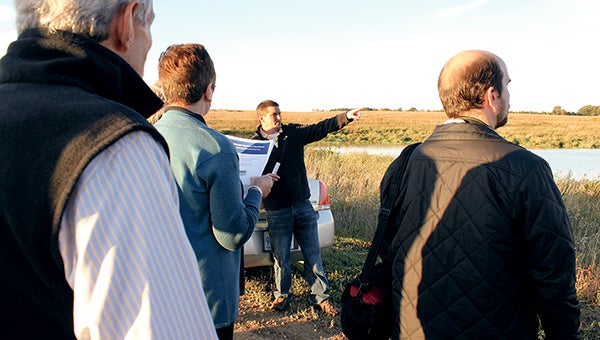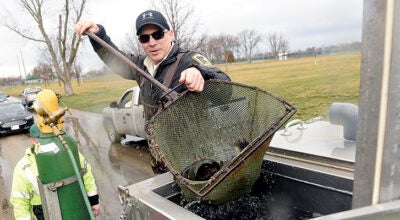Investment committee tours area, eyes future projects
Published 11:40 am Thursday, October 10, 2013

Justin Hanson, CRWD resource specialist, describes the work the CRWD and contractors have done to create a detention pond northwest of Austin. Matt Peterson/matt.peterson@austindailyherald.com
By Matt Peterson and Sarah Stultz
About 20 people stood on a gravel road shortly after sunrise and looked over what seemed to be an ordinary pond in a field on Wednesday.
With hopes of securing more future state funding for flood control and sediment reduction, Justin Hanson explained how this was no ordinary pond.
It was the first stop of the day for the Minnesota House’s Capital Investment Committee, which toured southeastern Minnesota and gathered ideas about where to allocate money for future state projects. Just northwest of Austin, the group listened to Hanson explain why the newer techniques for flood and sediment reduction get more bang for the buck.
“This isn’t traditional flood control, the stuff you guys probably hear about,” Hanson said.
Hanson referred to the detention pond, which sits in lowland, next to the road and almost acts like a sponge. One couldn’t quite tell, but the road had also been raised four and a half feet. Instead of installing a culvert and quickly draining the water away, the Cedar River Watershed District and contractors installed a large pond with a small drain leading under the road. In even the heaviest rain events, the water will not come over the road, and the runoff rate toward the river is significantly reduced.
“It’s such an important issue to slow the water down,” Hanson said.
To some, the project made more sense than past measures, such as putting up giant berms to hold the water, or gutting big trenches. Capital Investment Committee Chairperson Alice Hausman (DFL-St. Paul) was impressed.
“This guy was so good at talking about it,” she said.
During the presentation, Hausman indicated funding such local projects is better than waiting for federal dollars and for the project to potentially be done the wrong way.
“Who’s going to be better at identifying the local landscape, FEMA or the local resource?” she said.
And Hanson listed multiple benefits of the project. Among flood reduction and sediment runoff, the detention pond creates a new habitat for many animals and protects farm fields.
Both Hausman Rep. Jeanne Poppe, DFL-Austin, said the presentation had an effect and should help secure more funding for such projects in the area.
After the presentation, the group headed to Albert Lea, where they listened to more pitches for the Blazing Star Trail and Fountain Lake.
Blazing Star Trail
Committee members gathered at the Blazing Star Trail prior to stopping at the Edgewater Bay Pavilion to hear a request for $500,000 for the extension of the trail from Myre-Big Island State Park to Hayward. Local officials also talked about the hope that the Blazing Star Trail will someday extend past Hayward to the west city limits of Austin and the Shooting Star Trail.
Craig Hoium, Austin community development director and ex-officio member of the Blazing Star Trail joint powers board, said the project already has about $1.75 million in previous bonding dollars to apply toward the development of the trail between the state park and Hayward.
The regional pedestrian trail was authorized by the 1996 Legislature as a State Legislative Trail, with the support of the Minnesota Department of Natural Resources and Minnesota Department of Transportation and local governments.
It presently begins at Frank Hall Park in Albert Lea to a point on the northeast side of Myre-Big Island State Park, about three-quarters of a mile from the western shore of Albert Lea Lake’s northern bay. The trail was built in 2003 after five years of land negotiations.
In a letter to Hausman, Hoium said if everything is on schedule, officials anticipate bids will be let the spring of 2014, with construction beginning the same year. The extension would be about 2.9 miles and would include a bridge over Albert Lea Lake.
Along with this, officials will pursue additional land acquisitions for the trail extension to Austin and the Shooting Star Trail, he said. Hoium attached multiple letters of support from community organizations.
Albert Lea Convention and Visitors Bureau Executive Director Susie Petersen talked about the attraction the trail can be for people coming into the state.
“We have a gem with the trails here, eventually connecting to Austin and Lanesboro,” Petersen said.
The committee headed to Faribault after their stops in Albert Lea.
More positive impressions
Hausman was further impressed with the Albert Lea requests for state bonding funds presented on the committee’s tour.
While in town, the legislators heard requests for $7.5 million to go toward the $15 million dredging of Fountain Lake.
Hausman said the first time she came to Albert Lea was when the city requested funds to clean the former North Edgewater Park landfill.
On Wednesday, as she heard the request for funds to go toward dredging Fountain Lake at the Edgewater Bay Pavilion, she said she thought back to that visit.
“We’re standing where that project started,” Hausman said.
City Administrator Chad Adams talked of the impact dredging the lake would have not only on Albert Lea but also on southern Minnesota and the rest of the state. Hausman said the presenters “told the story well,” as they emphasized the importance of the lake and Albert Lea to people coming in from Minnesota from Iowa.
“As a gateway community, we think it’s important to give people the wow factor,” said Watershed District Administrator Brett Behnke.
Andy Henschel, director of field operations with the Watershed District, said the 550-acre Fountain Lake has an average depth of six feet with the deepest part being 12 feet.
Over the years, he said, the lake has become filled with sediment — with as much as five to eight feed accumulated in some areas — resulting in water quality impairment and large algae blooms nearly every year. This affects water clarity, wildlife habitat and recreation.
The cost of the project comes from the dredging itself, along with studies, permits, land acquisition and construction. If the state funds are obtained, the other half would be paid for money raised through the local-option, half-cent sales tax.
The Shell Rock River Watershed District has completed several projects to control sediment from upstream and has seen improvements, but officials believe more improvement can come from the dredging.
The district has led the Pickerel Lake reclamation project, the installation of filter strips and rock outlets, conservation programs, street sweeping, rainwater gardens and septic system inspections.
District 27A Rep. Shannon Savick, DFL-Wells, said she would do whatever she needed to help move the project forward. She thinks the Fountain Lake dredging project will increase economic development in the area.
“It could bring a lot of money to the area, bring the jobs back and keep our children here,” she said.



